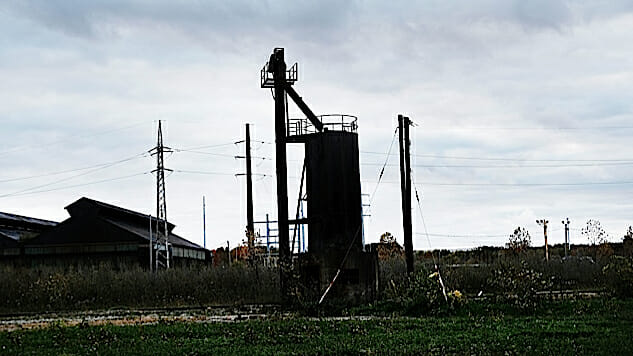The Real Way to “Bring Jobs Back” to Rural America
An interview with an Iowa-based small business developer
Photo by Spencer Platt/Getty
We’ve heard a lot during this past election campaign about the plight of small town and rural America and how the economic challenges of these places have tended to be neglected by the national political debate. Many of the small town and rural communities that predominantly voted for Trump have been struggling through years of lost jobs, declining populations and various challenges related to that. Trump has promised to “bring jobs back” to these struggling communities, but the economic reality is that the jobs of the past are unlikely to come back; they’ve been permanently replaced or made obsolete by automation, globalized outsourcing, and other powerful economic trends that are bigger than any president’s power to change.
But instead of looking to “bring back” the jobs of the past, maybe rural America needs to focus on encouraging and welcoming the jobs of the future. The fact is, aside from the gloomy rhetoric of the national political campaign, there is already a lot of good, promising economic development activity happening in small towns and rural areas on the local level. Instead of trying to bring jobs back from industries that are already in decline due to automation and other larger trends, we should do more to support the talented people on the ground in those communities who are already doing good work to create jobs in the small business sector and make their communities more attractive places to live in ways that are relevant to their existing populations and building on their existing strengths.
One person who is actively involved in this effort is my friend Zachary Mannheimer, who is the Vice President of Creative Placemaking at Iowa Business Growth, an SBA-certified small business lender and New Market tax credit developer based in Des Moines. Zack works with small businesses and small town communities to develop new “creative spaces” where artists and creative professionals can flourish in unexpected places: small town and rural Iowa. Zack believes that rural America has a big opportunity to be the next center of creative economic development and net migration, as creative young people look for affordable housing and unique communities away from expensive, competitive big cities. Instead of handing out tax giveaways to big businesses, Zack believes that small towns can get better results by taking a long-term grassroots approach of making their communities more hospitable to creative and entrepreneurial talent, rehabilitating old buildings, and crafting public amenities for the arts.
Does the idea of wanting to move to a smaller town sound crazy to you big-city folks? Well, Zack’s own life is an example of how it can be possible. He used to live in New York City, and then relocated to Des Moines, Iowa (a small city of approximately 600,000 people) because he saw an opportunity to do good creative work there in a way that wouldn’t have been possible in the high-cost, highly saturated market of New York. Prior to joining Iowa Business Growth, Zack helped found a creative nonprofit organization in Des Moines (headquartered in a renovated Art Deco firehouse) called the Des Moines Social Club, which has been well supported by the city and has become a hub of creative activity in theater, music, art, culinary classes, comedy and more. Des Moines used to be mainly thought of as a “boring” place where people moved to if they wanted to work for an insurance company and slowly drink themselves to death, but today the city is attracting national recognition as a surprisingly hip city with a thriving cultural scene. Other “small towns” could follow in Des Moines’ footsteps.
I spoke with Zack about his work in small town Iowa and what he sees as signs of hope for rural America’s future.
Please tell us a bit about what you do in your job for Iowa Business Growth. How are you helping rural communities create new jobs and growth? What are the key challenges and selling points of rural America in today’s economic climate?
The ultimate goal of what I’m trying to do is address the question of “how do you remake areas?” And we look at that question from a business side and from a cultural side. The business side is: how do you help struggling rural communities break out of the mindset of chasing a giant manufacturing company and competing for tax breaks to lure 30 or 40 jobs, where the chance of success is low, and the incentives are the same, so it’s a zero sum game, race to the bottom. Every town in America is chasing those same jobs and trying to offer those same tax incentives, so it doesn’t work for long.
Instead, the best way for towns to compete is on quality of life; what’s going on in that community, why do people want to move here and live here. 10 years ago this concept of “economic development based on quality of life and creative amenities” would have been laughable; today these towns are doing it sometimes out of necessity. So our overall mission at my new job is to help remake these towns to be more unique and culturally vibrant.
The cultural side of the equation has to do with looking at how and why young people are moving within America. If you track net migration of young people, anyone in their 20s or 30s who is creative or entrepreneurial who has not “made it” by becoming a millionaire, they’re starting to move away from big, expensive cities on the coasts for lower-cost cities in the Midwest like Minneapolis and Kansas City and Austin and Denver. That’s because the big cities on the costs are oversaturated—it costs too much to live there and it’s too hard to break through. I would argue that these lower-cost Midwestern cities are also becoming oversaturated in the same way as New York and L.A. and San Francisco. So the next wave of migration that you’re going to see in the next few years, will be more migration to even smaller cities like Des Moines, and Boise and Tulsa.
And after 10 or 20 years: places like Des Moines are going to be oversaturated with unaffordable housing. We’re already seeing this in neighborhoods like downtown Des Moines, where there are great apartments and condos but they’re often unaffordable for 20-somethings. So what’s left? The next wave will be smaller towns, and broadly speaking, “rural” areas: places like Dubuque, and Fort Dodge, and Mason City, Iowa, and even smaller communities, if these towns are willing to adapt to attract that next wave of migration and growth.
I’ve seen this happen in my own life. I lived in New York for 10 years and I’m an aging theater artist. Artists and entrepreneurs are often moved to the fringes of society by financial necessity—but also from a creative standpoint. Back in the 1960s—and this sounds crazy today—artists and musicians and writers moved to Manhattan because of cheap rent. But today, if you want to be a creative pioneer, the last place you should be is a large city. And lots of creative people in big cities don’t want to hear this; they’d rather give up their art than move away from the big expensive city that they love.
But I truly believe, if you look at the overall trends, if there was ever a time for rural America to stake their claim to become the next place for talented creative people to move to, it would be now.
We hear a lot about the economic challenges facing small towns and rural areas. But what about the flip side? What do you see as some inherent strengths that these communities have, which they might not fully realize or fully be utilizing?
Lots of small towns that I see have significant strengths. And this may be one that the towns may not want to hear, but they tend to present a very interesting “blank canvas” where the town has great bones; they have great architecture and charming old Main Street buildings that go right up to the curb. The streets could be walkable. They’ve got great community pride. And people can go there and create and see an immediate impact. That’s a big reason why I left New York; I was there for 10 years. I could have started something like the Des Moines Social Club in New York but it would have taken the rest of my life and a hundred million dollars.
Another aspect, from a creative standpoint of why I wanted to leave New York is that in Brooklyn, I was in a bubble of people who agreed with me and everybody in the audience for my play already shared my viewpoint. Ultimately, that’s not what you want to have from a creative standpoint; you need the tension and vigor of dealing with different perspectives around you.
The difference between Des Moines and New York is very similar to the difference between Fort Dodge and Des Moines. As a creative professional, there are inherent advantages of living and working in a smaller community, if you’re willing to play a long game. If you want a surrounding community that looks and acts exactly like you, sure, stay in Brooklyn or San Francisco or your comfortable neighborhood in Des Moines.
But artists always migrate to lower costs of living and creative blank canvases. People used to migrate from rural to urban; now that the big cities have gotten so expensive and competitive and stressful, people are going to start looking to go in the other direction.
Soon, we’re going to have driverless cars. Transportation is going to change. Rural settings can be perfectly set up for what young people are looking for; lots of young people today don’t want to own a car, they want to work remotely. With driverless cars, in just a few years, you could live in a small town outside a larger city and have a really nice, lower-cost lifestyle, and commute by driverless car into the larger urban areas. This means that the value proposition of small town and rural living is about to get a lot more compelling. Lots of futurists and theorists are predicting this.
It’s true that driverless cars can produce big disruption and cause lots of lost jobs—in sectors like gas stations, taxi drivers, car repair—and yet there can be a brand new gain of jobs if the right education is there and the right infrastructure is in place.
Another major opportunity for rural areas is the rise of 3D printing and “maker culture” and new types of manufacturing, including bio-based manufacturing. Rural areas can be more nimble than big cities in adapting to things like driverless cars, and embracing new types of manufacturing, because of the small towns’ greater ease of dealing with their land use zoning and codes. If I were on the city council or economic development board in a rural area, I would be looking to change the codes and help corner the market on new types of production and manufacturing.
What are some recent success stories that you’re seeing in rural Iowa?
Rural America has work to do to get people to move back there; we need to incentivize people, just like we incentivized companies.
Newton, Iowa has a very innovative housing incentive model right now. If you build a home in Newton, Iowa with a value of $160,000 or more, the city will give you $10,000 and will give you a membership at the YMCA, give you season tickets for the Iowa Speedway, and buy you a lawnmower. They’re getting very directly involved with incentivizing people to make that decision to move there and become homeowners there.
Another idea that my company is working on right now is more indirect, but it relates to the two biggest challenges that rural areas tend to be worried about: 1. Workforce recruitment and 2. Housing stock.
Unemployment in rural Iowa is low, but mainly because they don’t have enough people to take the available jobs. Sometimes it’s not the dollar value of the salary that’s the issue, sometimes it’s worries about quality of life; some of these towns struggle to recruit people even for six-figure salaried jobs, because people are concerned about “What will I do for fun,” “how will I find people to date,” and all of that.
So let’s say that your town has a challenge with recruiting and retaining public school teachers. If you think about a young person right out of college taking a teaching job in a small town, often they are there because they kind of “settled” for that small town; they might have preferred to be in a bigger city, and then as soon as a teaching job opens up in a bigger city, they leave the small town. So instead of incentivizing people with more money, which the towns don’t have, lots of these young professionals want modern rental units, which mostly don’t exist in rural Iowa.
So my company, Iowa Business Growth, is now looking at creating street-level nonprofit amenities, like live music, performing arts spaces, and libraries. And we’re working on being able to offer a deal to the individual young teachers in this town, along the lines of, if you agree to move to the town and work in the public school system for 3 years, and you want to live in one of the cool, modern apartments in our building, we will underwrite your rent by $200 per month and pay down your student loans by $1,000 per year, and we will ask you to do some community service hours to help embed people further in the community.
This is a simple model that we think can be replicated in lots of towns, and we can do it mostly privately without relying too much on tax dollars. But the idea is, we could set up a building with 20 housing units—lots of these towns have gorgeous old buildings with distinctive architecture that would be amazing to refurbish as apartments. And then we could renovate the building, set up a nonprofit amenity on the ground floor to help subsidize the apartments. Rather than asking the school district to incentivize the teachers with more tax dollars, the private developer and the town itself, invests in the town and uses a mix of public and private funds to underwrite the rent for the school teachers and subsidize their student loans.
Lots of small towns assume that most of the kids who grow up there are going to move away. And I’m an advocate for getting away from your hometown to see the world, and then go back to your hometown if you want. But what if you grow up in Chicago or New York, why is rural Iowa not part of “the world” that you want to go out and see? Most young people today don’t move somewhere based on jobs, they move based on lifestyle and culture and not needing to have a car. You can offer that in rural areas, but we’re just not offering it and sending that message. The metric we’re not looking at right now is the glut of 20-to-30-year-olds that are living in big urban areas. We’re going to see a rise of young people who are open to moving to smaller towns if the right amenities are ready for them.
For the past 30-40 years, kids from small town Iowa have grown up and gone to college and moved away to Chicago and New York. We’ll know that the types of efforts I’m working on are successful if, in a few years, we can start to see more college grads from Chicago and New York moving to places like Dubuque and Fort Dodge, Iowa—not for “a job” but for culture and lifestyle.
Instead of handing out a $30 million tax incentive to a big manufacturing company that might not even create all the jobs they promise, we can make small towns more creative places that are ready for the next wave of economic opportunity and population growth. And we can do almost all of this privately, without tax money. And by building up the cultural scene, all it takes is for one person—one artist or musician that comes out of that small town to make that town really relevant.
What are going to be the next sources of job growth in small towns and rural areas?
“Bringing the old jobs back” to rural America was a silly topic of conversation in this past election; even if we ended NAFTA tomorrow, it’s not like those same types of jobs are going to come back.
Instead, we have to look for the new jobs of the future, and rural communities have big strengths and opportunities to be centers of growth in sectors like contour crafting, 3D printing, maker technology, driverless car technology, and drone technology. Lots of these technologies are going to be related to helping reduce the geographic isolation of rural areas. The biggest problem for these communities (geographic isolation) is also the biggest opportunity.
We know how to get more artists into rural areas: we need to look to create more residency programs and build a better network of residency programs for artists. Artists will live and work anywhere and it doesn’t cost much to invite them. Omaha has a great residency program for artists at the Bemis Center that could be a model for other programs in small towns. Most existing artist residency programs focus on literature or visual arts; we need more residencies for theater, music, dance, and culinary arts. Rural communities could do this and make a name for themselves in these creative fields.
If you’re an artist or entrepreneur and your goal is not fame and money, you should not be living in a large city. If you want to make a difference not just in your life but in the lives of a community, there is lots of opportunity out there.
When I started the Des Moines Social Club, I was an out-of-town guy from New York City who didn’t know anyone in Des Moines, but it was a small enough community that I could quickly meet the right people and build relationships: the city was ready for it. I think the same thing can be said for rural America. There is opportunity there, and creative people have to get past the obstacle of thinking that “I have to live a certain lifestyle surrounded by people who think and act just like me.”







































